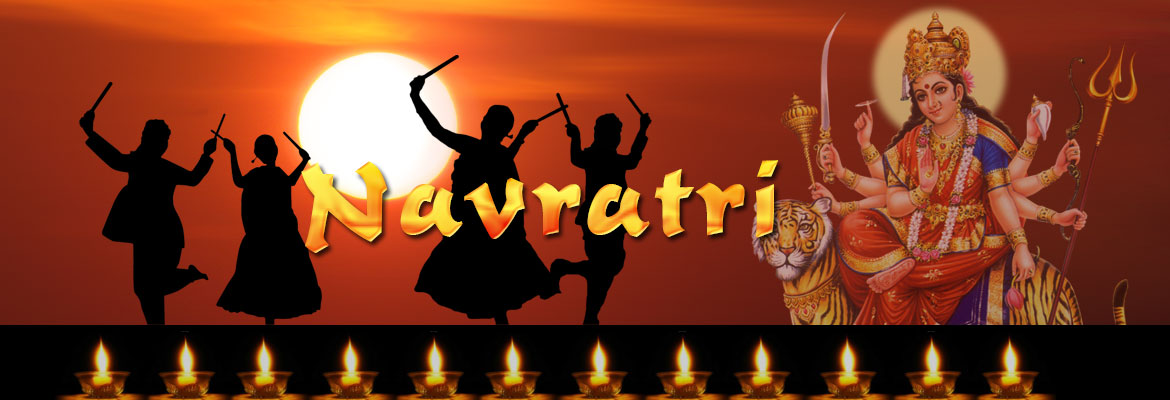
Navratri 2024
One of the greatest Hindu festivals is called Navratri, Navratras, Navrathri or Durga Puja are the different names, different idols, and different manner of celebration, but the underlying theme remains the same. It is the celebration of Good over Evil; of the greatness and valour of Devi Durga; the Giver of Peace, Prosperity and Well being of the mortals. TheHolidaySpot is happy to present to you a world of information related to the Holy Navratri Festival you can share with everyone you care about and elevate the festive mood. Wish you all A Happy Navratri.
Navratri 2024 will begin on Thursday, 3rd October and ends on Saturday, 12th October.
Ashadha Gupt Navratri 2024 will begin on Saturday, 6th July and ends on Monday, 15th July.
Chaitra Navratri 2025 will begin on Sunday, 30th March and ends on Monday, 7th April.
The ten-day battle between Durga and Mahishasura, known as Navaratri, is divided into distinct phases, each marked by a different manifestation of the goddess and a specific significance. Here is a more detailed description of the ten days:
Day 1: Shailaputri - The first day is dedicated to Shailaputri, the daughter of the mountains. Durga is worshipped as Shailaputri, symbolizing strength and stability. She is depicted with a trident in her right hand and a lotus flower in her left hand.
Day 2: Brahmacharini - On the second day, Durga is worshipped as Brahmacharini, representing the pursuit of knowledge and wisdom. She is depicted as a divine scholar and is associated with the power of penance and self-control.
Day 3: Chandraghanta - The third day is dedicated to Chandraghanta, who represents bravery and courage. She wears a half-moon (Chandra) on her forehead, giving her the name Chandraghanta. She is depicted with ten arms, holding various weapons and riding a tiger.
Day 4: Kushmanda - On the fourth day, Durga is worshipped as Kushmanda, the creator of the universe. It is believed that she resides within the Sun, radiating light and energy. She is depicted with eight arms and is associated with health, prosperity, and abundance.
Day 5: Skandamata - The fifth day is dedicated to Skandamata, the mother of Lord Skanda (also known as Kartikeya or Murugan). She is depicted with four arms, holding her son Skanda on her lap. She represents the nurturing and protective aspect of motherhood.
Day 6: Katyayani - On the sixth day, Durga is worshipped as Katyayani, the warrior goddess. She is said to have been born as the daughter of sage Katyayan and is associated with valor and victory. She is depicted with four arms and riding a lion.
Day 7: Kalaratri - The seventh day is dedicated to Kalaratri, the fierce and dark form of Durga. She is believed to destroy ignorance and remove darkness from the lives of her devotees. She is depicted with a dark complexion, disheveled hair, and a fearless expression.
Day 8: Mahagauri - On the eighth day, Durga is worshipped as Mahagauri, symbolizing purity and serenity. She is depicted as a radiant and peaceful goddess, often dressed in white. She is associated with peace, tranquility, and spiritual enlightenment.
Day 9: Siddhidatri - The ninth day is dedicated to Siddhidatri, the giver of supernatural powers and accomplishments. She is believed to bless her devotees with divine abilities and spiritual knowledge. She is depicted with four arms and surrounded by celestial beings.
Day 10: Vijayadashami - The tenth day, also known as Vijayadashami, marks the culmination of the battle. On this day, Durga is worshipped as Mahishasuramardini, the form in which she slays Mahishasura. It signifies the victory of good over evil and is celebrated with processions, cultural performances, and the immersion of Durga idols in water.
Each day of Navaratri holds its own significance and represents different aspects of Durga's power and divine qualities. Devotees worship and invoke these forms of the goddess to seek blessings, strength, and spiritual upliftment during the ten-day festival.
The triumph of Durga over Mahishasura symbolizes the victory of good over evil, righteousness over wickedness, and the power of divine femininity. It is a story of courage, devotion, and the ultimate triumph of righteousness, and it continues to be celebrated with great fervor and enthusiasm during the festival of Durga Puja.

 Friendship Day
Friendship Day
 Good Morning
Good Morning